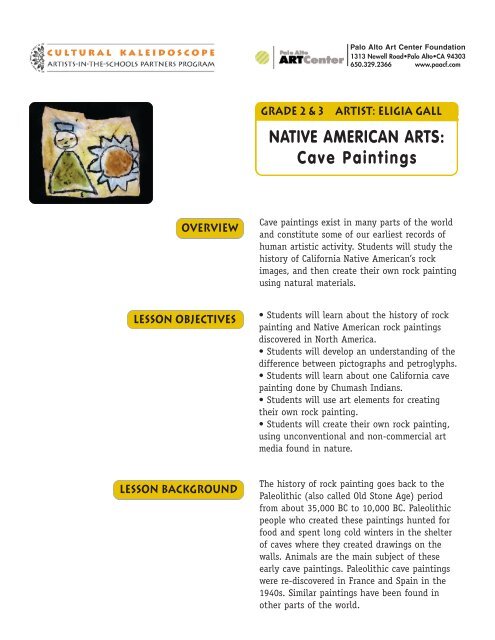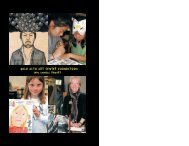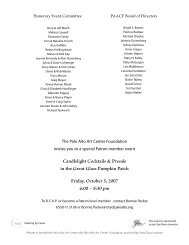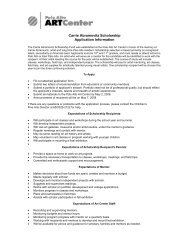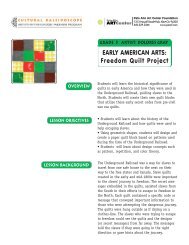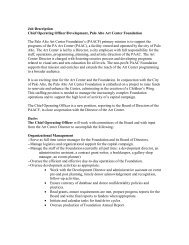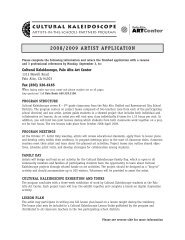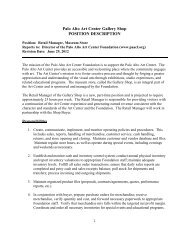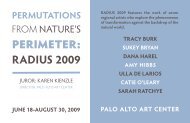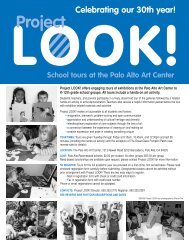NATIVE AMERICAN ARTS: Cave Paintings - Miss Hope.org!
NATIVE AMERICAN ARTS: Cave Paintings - Miss Hope.org!
NATIVE AMERICAN ARTS: Cave Paintings - Miss Hope.org!
Create successful ePaper yourself
Turn your PDF publications into a flip-book with our unique Google optimized e-Paper software.
Palo Alto Art Center Foundation<br />
1313 Newell Road•Palo Alto•CA 94303<br />
650.329.2366 www.paacf.com<br />
GRADE 2 & 3<br />
Artist: Eligia Gall<br />
<strong>NATIVE</strong> <strong>AMERICAN</strong> <strong>ARTS</strong>:<br />
<strong>Cave</strong> <strong>Paintings</strong><br />
OVERVIEW<br />
<strong>Cave</strong> paintings exist in many parts of the world<br />
and constitute some of our earliest records of<br />
human artistic activity. Students will study the<br />
history of California Native American’s rock<br />
images, and then create their own rock painting<br />
using natural materials.<br />
LESSON OBJECTIVES<br />
• Students will learn about the history of rock<br />
painting and Native American rock paintings<br />
discovered in North America.<br />
• Students will develop an understanding of the<br />
difference between pictographs and petroglyphs.<br />
• Students will learn about one California cave<br />
painting done by Chumash Indians.<br />
• Students will use art elements for creating<br />
their own rock painting.<br />
• Students will create their own rock painting,<br />
using unconventional and non-commercial art<br />
media found in nature.<br />
LESSON BACKGROUND<br />
The history of rock painting goes back to the<br />
Paleolithic (also called Old Stone Age) period<br />
from about 35,000 BC to 10,000 BC. Paleolithic<br />
people who created these paintings hunted for<br />
food and spent long cold winters in the shelter<br />
of caves where they created drawings on the<br />
walls. Animals are the main subject of these<br />
early cave paintings. Paleolithic cave paintings<br />
were re-discovered in France and Spain in the<br />
1940s. Similar paintings have been found in<br />
other parts of the world.
MATERIALS<br />
Flat Sand Stone Slab (approx. 6”x 6”)<br />
(1 per student)<br />
Small pointed rock for carving design<br />
(1 per student)<br />
Charcoal (black)<br />
Purple Cabbage (blue)<br />
Pomegranate Skin ( red)<br />
Lemon Peel (Yellow)<br />
Green Leaves (Green)<br />
Scratch paper<br />
Pencil<br />
Acrylic Sealer (optional–for teacher use<br />
only)<br />
RESOURCES<br />
Arnold, Caroline. Stories in Stone: Rock<br />
Art Pictures by Early Americans. N.Y.:<br />
Clarion Books, 1996.<br />
Pierre, Yvette La. Native American Rock<br />
Art: Messages from the Past.<br />
Charlottesville: Thomasson-Grant, Inc.,<br />
1994.<br />
Hodge, Susie. Prehistoric Art. Des Plaines,<br />
IL: Heinemann Interactive Library, 1998.<br />
White, Randall. Prehistoric Art: The<br />
Symbolic Journey of Humankind. N.Y.:<br />
Harry N. Abrams, Inc, 2003.<br />
Mancini, Salvatore. On the Edge of Magic:<br />
Petroglyphs and Rock <strong>Paintings</strong> of the<br />
Ancient Southwest. S.F.: Chronicle Books,<br />
1996.<br />
The Santa Barbara Museum of Natural<br />
History, Santa Babara, Welcome to<br />
Chumash Indian Life, http://www.sbnature.<strong>org</strong>/research/anthro/<br />
chumash/indes.html, 13 September<br />
2006.<br />
Like ancient peoples in other lands, Native<br />
Americans used rock painting as a way to record<br />
their beliefs and observations of the world.<br />
Their pictures range in style and subject from<br />
simple squiggly lines to elaborate battle scenes.<br />
Today rock art sites inspire visitors to wonder<br />
about the people who made the images and the<br />
messages they may have been trying to communicate.<br />
One Native American rock art site is<br />
known as the Chumash Indian Painted <strong>Cave</strong>,<br />
located in the hills above Santa Barbara,<br />
California. This is one of the most elaborate<br />
and colorful rock paintings in the world.<br />
VOCABULARY<br />
Art Elements: the "building blocks" that artists<br />
manipulate to make a work of art. The seven<br />
elements of art are line, shape, space, texture,<br />
color, value, and form. The way an artist uses<br />
the elements will effect the feeling the audience<br />
gets from the piece of art.<br />
Culture: the traditional or typical activities,<br />
including clothes, food, dwellings, beliefs and<br />
various customs of a group of people.<br />
Petroglyph: An image made by carving or<br />
pecking on rock.<br />
Pictograph: a simplified picture or pictorial<br />
symbol that represents a word, phrase or idea.<br />
Pictographs are considered the earliest form of<br />
writing.<br />
Prehistory: The period of time before humans<br />
used standard forms of writing to record<br />
information.<br />
Rock Art: Images painted or carved on rock<br />
surfaces.<br />
Shaman: In Native American culture, a person<br />
with supernatural powers for healing and<br />
communicating with spirits, also called a<br />
“medicine man”.
INTRODUCTION<br />
Start a lesson by showing pictures of Altamira<br />
and/or Lascaux cave paintings (accessible<br />
through a Google search). Ask students when<br />
and why they think the images were made. Art<br />
historians think that the paintings were made to<br />
magically help the hunt. For example, images<br />
that show hunters hunting successfully were<br />
thought to increase the chance of bringing back<br />
food. Shamans came to the caves to perform<br />
ritual ceremonies and to represent the beliefs of<br />
their culture. Show students the images of Native<br />
American cave paintings such as Navajo and/or<br />
Pueblo cave paintings. Discuss the difference<br />
between a petroglyph and a pictograph. Show a<br />
picture of the painting done by the Chumash<br />
Indians. Ask students to consider why the artist<br />
may have made the painting and what story it<br />
might tell. Chumash rock paintings were probably<br />
made for religious reasons. Shamans probably<br />
made them to influence supernatural beings<br />
and force them to intervene in human affairs.<br />
Talk about where and how the Chumash Indians<br />
lived. About 13,000 years ago, the Chumash<br />
Indians lived along the California coast between<br />
Malibu and Paso Robles, as well as on the<br />
Northern Channel Islands. The population<br />
increased over time and the people adapted<br />
their way of life to the local environment. The<br />
people started trading with one another. The<br />
invention of the canoe (tomol), about 2000<br />
years ago, made this possible. The Chumash<br />
Indians are known for their fine basketry, their<br />
money made from shells, and their mysterious<br />
cave paintings.<br />
Discuss the materials used to paint caves and<br />
where they might have been found. Animal<br />
bones were used to carve and to peck in the<br />
stone. Red was made from an iron oxide called<br />
hematite; white came from gypsum or diatomaceous<br />
earth made of the calcium-rich shells of<br />
sea creatures.; black came from charcoal. These<br />
ground up pigments were mixed with water,<br />
animal fat, or plant juices to make them into<br />
paint, which North American artists applied to<br />
the rock with their fingers or with brushes made<br />
from the hair of animal tails.<br />
STEP BY STEP<br />
Preparation<br />
1. The lesson teacher should create a sample<br />
rock painting in order to understand the process<br />
and to provide an example for students.<br />
2. Distribute Chumash, Navajo, and Pueblo<br />
designs.<br />
3. Distribute scratch paper for students to<br />
practice drawing Chumash, Navajo and Pueblo<br />
designs.<br />
4. Ask students to decide which design they<br />
want to put on their rocks.<br />
5. Distribute materials, 6”x 6” flat stone slabs,<br />
fruit skins and vegetables for color pigments,<br />
and small pointed stones.<br />
6. Show students how use the small pointed<br />
stone to draw a design on the stone slabs.<br />
7. Have freshly cut vegetables and fruit skins to<br />
color the design.<br />
8. If possible, the teacher seals the finished slab<br />
with acrylic sealer to protect the painting<br />
design.<br />
During the Lesson<br />
Encourage students to consider the size of their<br />
designs in order to fill the page. Instead of<br />
using only one color, have students use different<br />
fruit skins and vegetables to make a more<br />
colorful rock painting, After being colored, the<br />
students can trace the outline of their designs<br />
one more time with the small pointed rock.<br />
This will help their designs stand out.
Chumash Designs
Navajo Designs
Pueblo Designs
Concluding the Lesson<br />
Cleaning up:<br />
Allow 10 minutes to clean up. Names can be<br />
marked in charcoal or carved on the stone.<br />
Vegetables can be composted and tables washed.<br />
If time and resources permit, the teacher can<br />
paint the finished slabs with acrylic sealer to<br />
protect and preserve the color.<br />
Post-project discussion:<br />
List the seven art elements; line, shape, space,<br />
texture, color, value, and form on the board.<br />
Have students do an art critique on their own<br />
rock painting by asking them the following<br />
questions:<br />
1. What symbols are in the rock painting?<br />
(description)<br />
2. What art elements were used?<br />
(analysis)<br />
3. What is the artist trying to say?<br />
What do I think about the artwork?<br />
What do I like about it? (Interpretation)<br />
5. How would I do it again, differently?<br />
The students’ designs may tell a story or be a<br />
symbol for a belief. Have students look at the<br />
images in the rock art and predict what might<br />
happen next, telling what clues in the work<br />
support their ideas. Have students write a poem<br />
or story inspired by their own works of art.<br />
Variations:<br />
This lesson can be incorporated with Language<br />
Arts and Social Studies. The students can create<br />
poetry based on their own rock paintings. On<br />
the Edge of Magic: Petroglyphs and Rock Painting<br />
of Ancient Southwest by Salvatore Mancini introduces<br />
Native American poems with Rock paintings.<br />
This reference may help students write<br />
poems. Studying Chumash Indian history and<br />
culture will help students develop an understanding<br />
about the customs of other cultures.
STANDARDS<br />
Grade 2<br />
1.3 Identify the elements of art in objects in nature, the environment, and works of art,<br />
emphasizing line, color, shape/form, texture, and space.<br />
3.1 Explain how artists use their work to share experiences or communicate ideas.<br />
3.3 Identify and discuss how art is used in events and celebrations in various cultures, past and<br />
present, including the use in their own lives.<br />
4.1 Compare ideas expressed through their own works of art with ideas expressed in the works<br />
of others<br />
Grade 3<br />
1.5 Identify and describe elements of art in works of art, emphasizing line, color, shape/form,<br />
texture, space, and value<br />
2.1 Explore ideas for art in a personal sketchbook.<br />
3.2 Identify artists from his or her own community, county, or state and discuss local or regional<br />
art traditions<br />
5.2 Have students write a poem or story inspired by their own works of art<br />
5.3 Look at images in figurative works of art and predict what might happen next, telling what<br />
clues in the work support their ideas.<br />
NOTES<br />
Cultural Kaleidoscope is provided to classrooms free of charge and is made possible by grants from the Hurlbut-Johnson Fund, Cisco Systems Foundation,<br />
Citibank Foundation, Washington Mutual Foundation, Wells Fargo Foundation, Palo Alto Weekly Holiday Fund, Arts Council Silicon Valley’s Community<br />
Art Fund, California Arts Council’s Youth Education in the Arts, Fenwick & West LLP, Morrison & Foerster LLP, the Palo Alto Art Center, City of Palo Alto<br />
and private donations.<br />
Cultural Kaleidoscope is a program of the Palo Alto Art Center Foundation. Cultural Kaleidoscope is provided to classrooms free of charge.


